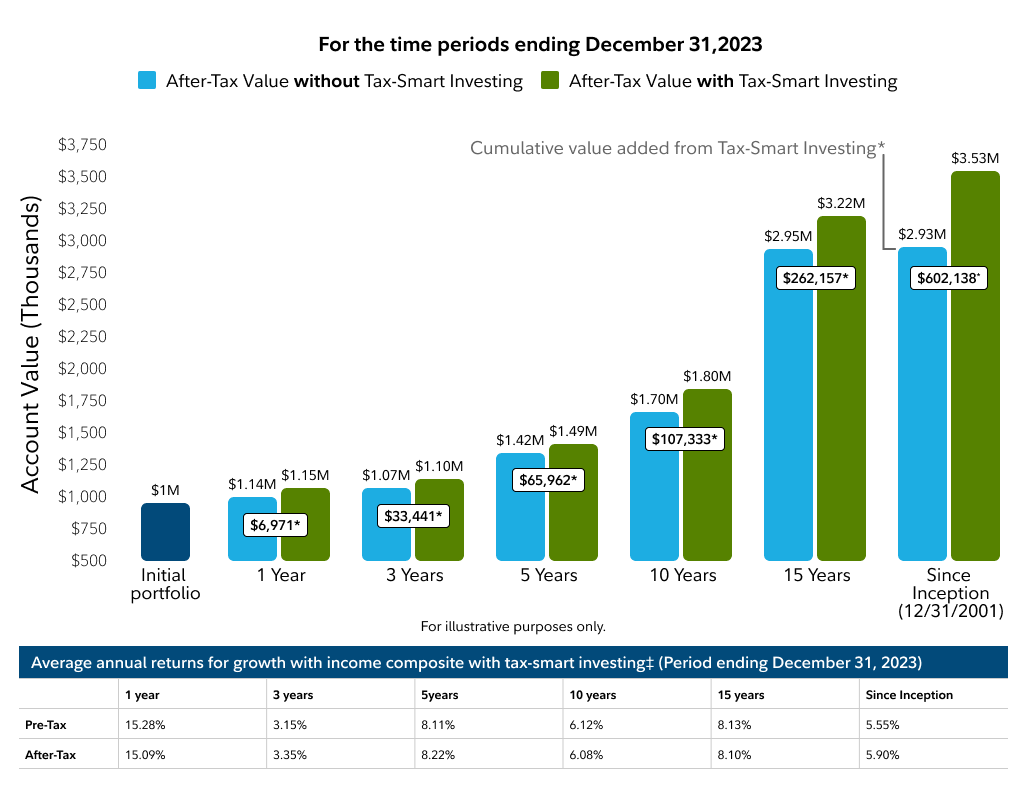1. A Life of Tax: How Much Tax Will Americans Pay Over Their Lifetime?, Self®. February 2024
2. Estate Tax: Definition, Tax Rates and Who Pays Nerd Wallet January 2024
3.
Tax-smart (i.e., tax-sensitive) investing techniques, including tax-loss harvesting, are applied in managing certain taxable accounts on a limited basis, at the discretion of the portfolio manager, primarily with respect to determining when assets in a client's account should be bought or sold. Assets contributed may be sold for a taxable gain or loss at any time. There are no guarantees as to the effectiveness of the tax-smart investing techniques applied in serving to reduce or minimize a client's overall tax liabilities, or as to the tax results that may be generated by a given transaction.
4. Fidelity advisors are licensed with Strategic Advisers LLC (Strategic Advisers), a registered investment adviser, and registered with Fidelity Brokerage Services LLC (FBS), a registered broker-dealer. Whether a Fidelity advisor provides advisory services through Strategic Advisers for a fee or brokerage services through FBS will depend on the products and services you choose.
*. Information about how we calculate the value of tax-smart strategies. We use a proprietary methodology to calculate an average annual net excess return to help measure the value of the tax-smart investing techniques. Our calculation uses asset-weighted composite pre-tax and after-tax performance information for Fidelity Wealth Services accounts managed using the strategy characteristics listed above. We compare this composite performance information to a reference basket of mutual funds and ETFs that we use to construct a tax-smart account's after-tax benchmark. Each fund represents a primary asset class, and is weighted in the same proportion as the primary asset class in the account's long-term asset allocation.
Average annual net excess return is calculated by subtracting pre-tax excess return from after-tax excess return. After-tax excess return is the amount by which the annualized after-tax investment return for the composite portfolio is either above or below the annualized after-tax benchmark return. Pre-tax excess return is the amount by which the annualized pre-tax investment return for the composite portfolio is either above or below the annualized pre-tax return of the reference basket of mutual funds and ETFs.
Important information about performance returns. Market indexes are included for informational purposes and for context with respect to market conditions. All indexes are unmanaged, and performance of the indexes includes reinvestment of dividends and interest income, unless otherwise noted. Review the definitions of indexes for more information. Please note an investor cannot invest directly into an index. Therefore, the performance of securities indexes do not incorporate or otherwise reflect the fees and expenses typically associated with managed accounts or investment funds.
Information about the calculation of account and composite returns. Returns for periods of one year or less in duration are reported cumulative. Returns for periods greater than one year may be reported on either a cumulative or average annual basis. Calendar year returns reflect the cumulative rates of return for the 12-month period from January 1 to December 31, inclusively, of the year indicated.
Reported rates of return utilize a time-weighted calculation, which vastly reduces the impact of cash flows. Returns shown assume reinvestment of interest, dividends, and capital gains distributions. Assets valued in U.S. dollars. Performance includes accrued interest for certain securities when provided by a third-party vendor; otherwise, performance returns are computed on a cash basis. Performance will be understated for periods when accrued interest information is not available. For accounts with individual bonds, amortization and accretion for bonds are not included in performance calculations. Performance reporting generally begins after the portfolio manager reviews the account and deems it ready for investment in the chosen strategy.
Rates of return shown are net of the actual investment advisory fees paid for each account, and are net of any applicable fee credits, any underlying fund's own management fees and operating expenses, and for certain Fidelity Wealth Services accounts the fees attributable to SMA sleeves. Strategic Advisers LLC (“Strategic Advisers”) includes performance from the time period when the program was offered by Fidelity Personal and Workplace Advisors LLC and subadvised by Strategic Advisers (other than the bond strategies offered through FSD) from July 2018 through March 2025 and for legacy programs offered by Strategic Advisers prior to July 2018. Fee schedules for these legacy programs differ from current fee schedules, and fees for accounts enrolled in those legacy programs may have been higher or lower than Strategic Advisers' current fees. Fee structures and services offered have changed over time. Please consult a Fidelity financial advisor or the applicable investment advisory program’s current Form ADV, Part 2A Brochure for current fee information. Additional information about our methodology for calculating pre- and after-tax performance return information is available at Fidelity.com/information in a document titled “About Managed Account Performance.”
Assumptions used in calculating after-tax returns. After-tax rate of return measures the performance of an account, taking into consideration the impact of a client's U.S. federal income taxes, based on the activity in the account. Strategic Advisers does not actively manage for alternative minimum taxes; state or local taxes; foreign taxes on non-U.S. investments; federal tax rules applicable to entities; or estate, gift, or generation-skipping transfer taxes. Strategic Advisers relies on information provided by clients in an effort to provide tax-sensitive investment management and does not offer tax advice. Any realized short-term or long-term capital gain or loss retains its short- or long-term characteristics in the after-tax calculation. The gain/loss for any account is applied in the month incurred and there is no carryforward. We assume that taxes are paid from outside the account. Taxes are recognized in the month in which they are incurred. This may inflate the value of some short-term losses if they are offset by long-term gains in subsequent months. After-Tax Returns do not take into account the tax consequences associated with income accrual, deductions with respect to debt obligations held in client accounts, or federal income tax limitations on capital losses. Withdrawals from client accounts during the performance period result in adjustments to take into account unrealized capital gains across all securities in such account, as well as the actual capital gains realized on the securities. Adjustments for reclassification of dividends from non-qualified to qualified status that occur in January of the subsequent year, are reflected in the prior December monthly returns.
We assume that a client reclaims in full any excess foreign tax withheld and is able to take a U.S. foreign tax credit in an amount equal to any foreign taxes paid, which increases an account's after-tax performance; the amount of the increase will depend on the total mix of foreign securities held and their applicable foreign tax rates, as well as the amount of distributions from those securities. We assume that losses are used to offset gains realized outside the account in the same month, and we add the imputed tax benefit of such a net loss to that month's return. This can inflate the value of the losses to the extent that there are no items outside the account against which they can be applied, and after-tax returns may exceed pre-tax returns as a result of an imputed tax benefit received upon realization of tax losses. Our after-tax performance calculation methodology uses the full value of harvested tax losses without regard to any future taxes that would be owed on a subsequent sale of any new investment purchased following the harvesting of a tax loss. That assumption may not be appropriate in all client situations but is appropriate where (1) the new investment is donated (and not sold) by the client as part of a charitable gift, (2) the client passes away and leaves the investment to heirs, (3) the client's long-term capital gains rate is 0% when they start withdrawing assets and realizing gains, (4) harvested losses exceed the amount of gains for the life of the account, or (5) where the proceeds from the sale of the original investment sold to harvest the loss are not reinvested. It is important to understand that the value of tax-loss harvesting for any particular client can only be determined by fully examining a client's investment and tax decisions for the life the account and the client, which our methodology does not attempt to do. Clients and potential clients should speak with their tax advisors for more information about how our tax-loss harvesting approach could provide value under their specific circumstances.
Information about composite returns. The rates of return featured for accounts managed to a long-term asset allocation represent a composite of accounts managed with the same long-term asset allocation, investment approach and investment universe as applicable; rates of return featured for accounts managed with a single asset class strategy represent a composite of accounts managed to the applicable strategy. Accounts included in the composite utilize a time-weighted calculation, which vastly reduces the impact of cash flows. Composites are asset-weighted. An asset-weighted methodology takes into account the differing sizes of client accounts (i.e. considers accounts proportionately). Larger accounts may, by percentage, pay lower investment advisory fees than smaller accounts, thereby decreasing the investment advisory fee applicable to the composite and increasing the composite's net-of-fee performance. For tax-smart accounts in Fidelity Wealth Services, composite results are based on the returns of the managed portion of the accounts; assets in a liquidity sleeve are excluded from composite performance.
Composites set minimum eligibility criteria for inclusion. Accounts with less than one full calendar month of returns and accounts subject to significant investment restrictions are excluded from composites (including fixed income strategies offered through Fidelity Strategic Disciplines with a state preference option). Accounts with a do-not-trade restriction are removed from the composite once the restriction has been applied to the account for thirty days. For periods prior to October 1, 2022, composite inclusion required a minimum investment level that reflected product-relative investment requirements. Effective October 1, 2022, product composites will reflect all accounts for which we produce a rate of return and that meet the aforementioned criteria. Non-fee paying accounts, if included in composite, will increase the net-of-fee performance. Certain products, like Fidelity Go®, offer investment services where accounts under a certain asset level do not incur investment advisory fees. Employees do not incur investment advisory fees for certain products.
Information about after-tax composite benchmarks. Return information for an after-tax benchmark represents an asset-weighted composite of clients' individual after-tax benchmark returns. Each client's personal after-tax benchmark is composed of mutual funds (index funds where available) and ETFs in the same asset class percentages as the client's investment strategy. The after-tax benchmark uses mutual funds and ETFs as investable alternatives to market indexes in order to provide a benchmark that takes into account the associated tax consequences of these investable alternatives. The after-tax benchmark returns implicitly take into account the net expense ratio of their component mutual funds because mutual funds report performance net of their expense. They assume reinvestment of dividends and capital gains, if applicable. The after-tax benchmark also takes into consideration the tax impact of rebalancing the benchmark portfolio, assuming the same tax rates as are applicable to each client's account, as well as an adjustment for the level of unrealized gains in each account. The after-tax composite benchmark return is calculated assuming the use of the "average cost-basis method" for calculating the tax basis of mutual fund shares.
Additional Information. Changes in laws and regulations may have a material impact on pre- and/or after-tax investment results. Strategic Advisers LLC relies on information provided by clients in an effort to provide tax-smart investing techniques. Strategic Advisers LLC can make no guarantees as to the effectiveness of the tax-smart investing techniques applied in serving to reduce or minimize a client's overall tax liabilities or as to the tax results that may be generated by a given transaction. Strategic Advisers does not provide tax or legal advice. Please consult your tax or legal professional for additional guidance. For more information about Strategic Advisers and its advisory offerings, including information about fees and investment risks, please visit our website at Fidelity.com.
The information contained herein includes information obtained from sources believed to be reliable, but we do not warrant or guarantee the timeliness or accuracy of the information as it has not been independently verified. It is made available on an "as is" basis without warranty.
Keep in mind that investing involves risk. The value of your investment will fluctuate over time, and you may gain or lose money.
Fidelity does not provide legal or tax advice, and the information provided is general in nature and should not be considered legal or tax advice. Consult an attorney, tax professional, or other advisor regarding your specific legal or tax situation.
Other than with respect to assets managed on a discretionary basis through an advisory agreement with Strategic Advisers LLC, you are responsible for determining whether, and how, to implement any financial planning recommendations presented, including asset allocation suggestions, and for paying applicable fees. Financial planning does not constitute an offer to sell, a solicitation of any offer to buy, or a recommendation of any security by Fidelity Investments or any third party.
Fidelity® Wealth Services provides non-discretionary financial planning and discretionary investment management through one or more Personalized Portfolios accounts for a fee. Advisory services offered by Strategic Advisers LLC (Strategic Advisers), a registered investment adviser. Brokerage services provided by Fidelity Brokerage Services LLC (FBS), and custodial and related services provided by National Financial Services LLC (NFS), each a member NYSE and SIPC. Strategic Advisers, FBS, and NFS are Fidelity Investments companies.
Fidelity Brokerage Services LLC, Member NYSE, SIPC, 900 Salem Street, Smithfield, RI 02917




![]() An opportunistic approach to tax savings
An opportunistic approach to tax savings![]() Asset location can enhance our approach
Asset location can enhance our approach![]() Help make your estate plan tax-smart
Help make your estate plan tax-smart![]() Tax reporting
Tax reporting
![]() Do you have a single, comprehensive approach that addresses all the taxes you could be facing?
Do you have a single, comprehensive approach that addresses all the taxes you could be facing?![]() Have you considered the impact taxes could have on your estate?
Have you considered the impact taxes could have on your estate?![]() Are you saving for retirement using accounts with different tax registrations, like a traditional and a Roth IRA? Have you considered whether they’re all working together in a tax-efficient manner?
Are you saving for retirement using accounts with different tax registrations, like a traditional and a Roth IRA? Have you considered whether they’re all working together in a tax-efficient manner? ![]() Does the paperwork that comes with tax season create a bottleneck for you? Would having someone help you prepare for meetings with tax professionals, including providing access to the numbers, make things easier for you?
Does the paperwork that comes with tax season create a bottleneck for you? Would having someone help you prepare for meetings with tax professionals, including providing access to the numbers, make things easier for you?



